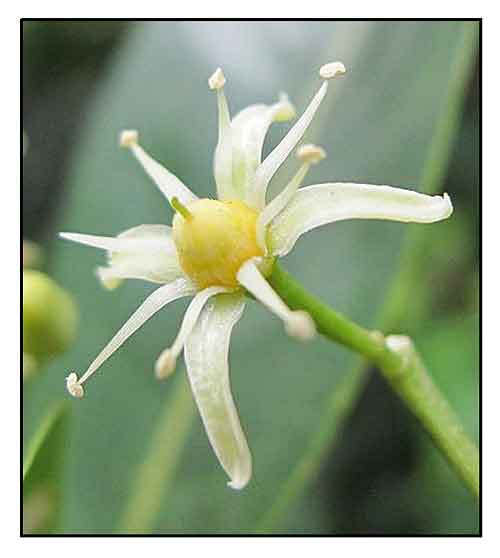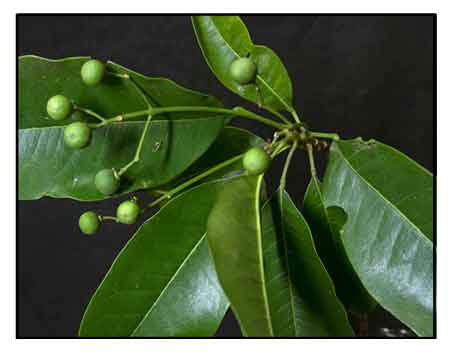 Botany Botany
Acronychia pedunculata is a shrub or small tree, to 28 m tall. Petiole glabrous to finely pubescent, 0.5-5 cm; leaflet blades usually elliptic to elliptic-oblong but grading to obovate, oblanceolate, or nearly oblong, 3.5-24.5 × 2-8.5 cm, base cuneate or sometimes rounded or attenuate, apex obtusely acuminate with an acumen to 2 cm or sometimes obtuse or rounded. Inflorescences 2-25 cm, few to many flowered. Pedicel 2-12 mm. Sepals 0.6-1.5 mm. Petals 4-12 mm. Ovary completely pubescent or rarely pubescent only at apex, with or without apical septicidal fissures; style pubescent at base, otherwise glabrous. Fruit subglobose or sometimes grading to ellipsoid, pyriform, or broadly conic, 0.5-1.5 cm in diam., with or without apical septicidal fissures, usually ± sparsely pubescent with ring of dense appressed trichomes at base but grading to tomentose or glabrous, apex often apiculate; outer part of pericarp (exocarp and mesocarp) drying 0.5-3 mm thick; mesocarp woody or subwoody. Seeds reddish black to black, 3-7 mm. (2)
 Distribution Distribution
- Native to the Philippines.
- Also native to Andaman Is., Assam, Bangladesh, Borneo, Cambodia, China, Himalaya, India, Jawa, Laos, Malaya, Myanmar, New Guinea, Nicobar Is., Sri Lanka, Sulawesi, Sumatera, Taiwan, Vietnam.
(1)
- Grows primarily in the wet tropical biome.
Constituents
- Study of stems isolated 8 known and 3 new acetophenones, namely: acrophenone A, B, and C (1-3), along with acrovestone (5), acropyrone (6), and acrovestenol (7). (see study below) (8)
Study of essential oil from aerial parts yielded 34 compounds, accounting for 92.8% of the oil. Major constituents were α-pinene (57.4%), and (E)-ß-caryophyllene (13.6%). (see study below) (10)
- Study of fruit of Acronychia pedunculata isolated a new prenylated flavone, acroflavone A (1), together with 8 known compounds (2-9). (see study below) (11)
- Phytochemical analysis of leaf and stem extracts yielded sterols, terpenoids, flavonoids, saponins, tannins, carbohydrates, resins, and glycosides, with absence of proteins. (see study below)
(12)
- Study of leaf essential oil yielded ß-selinene 1.57%, bis (2-ethylhexyl)phthalate 3.17%, monoterpene hydrocarbons 29.52%, oxygenated monoterpenes 1.95%. sesquiterpene hydrocarbons 43.12%, oxygenated sesquiterpenes 18.72%, non-terpenes 5.69%, total identified 98.99%.
(13)
- Study of roots isolated six known and three new acetophenones
D, E, F (1-3) (see study below) (6)
- Study of stem bark isolated a new isoprenylated acetophenone, acronyculatin P (1) as well as two known compounds, 3',5'-diisoprenyl-2',4'-dihydroxy-6'-methoxyphenylethanone (2) and 3'-isoprenyl-2',4',6'-trihydroxyphenylethanone (3). (see study below) (15)
Properties
- Studies have shown anti-inflammatory, antinociceptive, antioxidant, antibacterial, antifungal, antiproliferative properties.
Parts used
Leaves, bark, roots, fruit.
 Uses Uses
Edibility
- Ripe fruits are edible with a sweet acidic flavor. Unripe fruits have a strongly astringent and resinous taste.(9)
- Tender leaves used in salads and as condiment.
Folkloric
- Bark used for skin irritation.
- Leaves used for rheumatism.
- In Sri Lankan traditional medicine,different plant parts i.e. leaves, roots, bark, and fruits used for treatment of cough, diarrhea, asthma, pruritus, pain, swelling, and various inflammatory disorders.
Leaves used in the form of medicinal oils and herbal porridge. (6) Poultice of leaves used on pimples. Paste from bark powder applied to swellings, sores, and ulcers.
- Bark used externally on swellings, fractures, sores, and ulcers. Taken internally as purgative. In Indochina, used as tonic against scabies.
Others
- Wood: Used for indoor construction, furniture, plywood, packing cases.
- Perfume: In China, aromatic and essential oils used for making perfumes. (9)
- Fish poison: Roots uses as fish poison in southern Vietnam.
- Wood: Used for house construction, for carving and making poles. (9)
- Incense: Wood also used for making incense; favored by Taoist practitioners who are forbidden from using sandalwood. (9)
Studies
• Evolitrine / Anti-Inflammatory / Antinociceptive / Leaves: Study evaluated the anti-nociceptive and anti-inflammatory activities and mechanisms of aqueous (AELA) and 70% ethanol crude extracts (EELA) and alkaloid fraction of fresh leaves extracts of A. pedunculata. Evolitrine was isolated as the major alkaloid and identified as an active anti-inflammatory and analgesic compound from the alkaloid fraction of EELA. Results showed dose-dependent acute anti-inflammatory activity in hind paw edema induced by carrageenan in Wistar rats. The anti-inflammatory and analgesic activities of evolitrine was comparable to reference drugs indomethacin and acetylsalicylic acid. The EELA showed a high safety margin in the limited dose acute toxicity study. (5)
• Acetophenones / Cancer Chemopreventive / Roots: Study of roots isolated six known and three new acetophenones. Acetophenones prenylacronylin (4) and acronyculatin D (10) exhibited significant inhibitory activity against 12-0-tetradecanoylphorbol 13-acetate-induced Epstein-Barr virus early antigen activation in Raji cells. (see constituents above) (6)
• Antibacterial / Various Plant Parts: Study evaluated six different aqueous water extracts of A. pedunculata for in vitro antibacterial activity against S. aureus and E. coli using disc diffusion antimicrobial susceptibility testing method. Results showed marked antibacterial activity against S. aureus (ATCC 25923) strain. Highest activity for combined aqueous sample of roots, stem bark, leaves, flowers and seed ingredients was observed in a concentration dependent manner. Results suggest potential as lead compounds for the development of potent, novel antibacterial agents from Acronychia pedunculata. (7)
• Acetophenones / Anti-Proliferative / Stems: Study of stems isolated 8 known and 3 new acetophenones, namely: acrophenone A, B, and C (1-3). Acrovestone (5), acropyrone (6), and acrovestenol (7) strikingly inhibited the proliferation of human leukemia cell lines. (8)
• Antimicrobial / Essential Oil / Aerial Parts: Study of essential oil from aerial parts yielded 34 compounds, accounting for 92.8% of the oil. The oil exhibited a broad spectrum of antimicrobial activity against various bacteria, particularly Salmonella enterica and Staphylococcus epidermis. (see constituents above) (10)
• Acroflavone A / Antibacterial / Fruits: Study of fruit of Acronychia pedunculata isolated a new prenylated flavone, acroflavone A (1), together with 8 known compounds (2-9). Three known compounds (3-5) demonstrated antibacterial activities, and among them, acrovestone (5) showed equal or more potent activity than chloramphenicol against three of four tested strains. (11)
• Antioxidant / Antibacterial / Leaves and Stems: Study evaluated the antioxidant and antibacterial potential of A. pedunculata leaf and stem extracts. Among the extracts, the leaf methanol extract exhibited maximum inhibition of test bacteria (E. coli, S. typhi, B. subtilis, S. aureus) and most prominent antioxidant activity. (see constituents above) (12)
• Antibacterial / Leaves and Stems: Study evaluated the antibacterial activity of fresh extracts of stem bark, leaves, and combined sample of stem bark and leaves against S. aureus ATCC 25923. Results showed antibacterial effect of each sample. The highest zone of inhibition was 11.67mm for the combined sample, which was attributed to synergistic activity of compounds from each plant material used. (14)
• Acronyculatin P / Anti-Murine Leukemia P-388 Cells / Stem Bark: Study of stem bark isolated a new isoprenylated acetophenone, acronyculatin P (1) as well as two known compounds, 3',5'-diisoprenyl-2',4'-dihydroxy-6'-methoxyphenylethanone (2) and 3'-isoprenyl-2',4',6'-trihydroxyphenylethanone (3). Compound 1, acronyculatin, showed moderate inhibitory activity against murine leukemia P-388 cells with IC50 of 15.42 µM. (15)
• Anticandidal / Leaves and Stems: Study evaluated the antifungal activity of leaf and stem bark extracts of A. pedunculata against five Candida species (C. albicans, C. krusei, C. parapsilosis, C. tropicalis, C glabrata and 8 clinical isolates) responsible for some human infections. All standard and clinical isolates showed inhibition zone width of ≥ 3 mm for both methanol extracts at 25 mg/ml except C. krusei with a 1.5-2 mm zone. Even at 10 mg/ml, methanol extracts showed considerable anticandidal activity. Results suggest potential for A. pedunculata as source of broad spectrum antimicrobial formulations. (16)
• Acrofoliones Apoptotic Effect on Leukemia Cells: Study evaluated the apoptotic activities of acrofolione A (1) and B (2) isolated from Acronychia pedunculata against human pre-B cell leukemia cell line (NALM-6). Acrofolione A (1) suppressed the growth of NALM-6, K562, and HPB-ALL cells with IC50s of 16.7, 17.9 and 10.1 µM, respectively. It markedly elevated caspase 3/7 activity and increased the number of TUNEL-positive cells. Cells treated by either compound showed enhanced expression of cleaved PARP and cleaved caspase 3 and &, and reduced survivin protein levels. Results suggest both acrofolione A and B may be useful in the treatment of various types of leukemia. (17)
Availability
Wild-crafted.
|

![]()



 Botany
Botany
 Uses
Uses